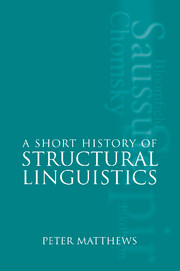5 - The architecture of a language system
Published online by Cambridge University Press: 03 December 2009
Summary
Let us return to synchronic linguistics. By the end of the 1930s, the description of sound systems had a theoretical foundation in the work of Trubetzkoy and others, and its method was increasingly codified. But the phonology of a language is again just one part of the total ‘language structure’. How do phonemes relate to, in particular, units of meaning? By what methods can these in turn be identified securely? What kinds of relation does each unit of meaning bear, in turn, to other units of meaning?
These were technical questions, and the elaboration of techniques of description, which is the most striking feature of linguistics in the decades that follow the Second World War, was not at first accompanied by new general or philosophical ideas. For the most part European linguists tended to found their work on those of Saussure, and linguists in America on Bloomfield's. The most exciting problems were of method, and those that concerned the detailed structure of a language system. For Trubetzkoy the ‘language structure’ had already been not one system but ‘several partial systems’ (‘mehrer Teilsysteme’) (Trubetzkoy, 1939: 6). These components ‘hold together, complement each other, and stand in mutual relations’ (‘so daß alle Teile einander zusammenhalten, einander ergänzen, sich aufeinander beziehen’). The main task for his successors was to say exactly how they do so, and exactly what the components are. It was in America especially that answers were given, and much of what was worked out in this period has found its way into textbooks and been taught for decades to generations of students.
- Type
- Chapter
- Information
- A Short History of Structural Linguistics , pp. 74 - 95Publisher: Cambridge University PressPrint publication year: 2001



